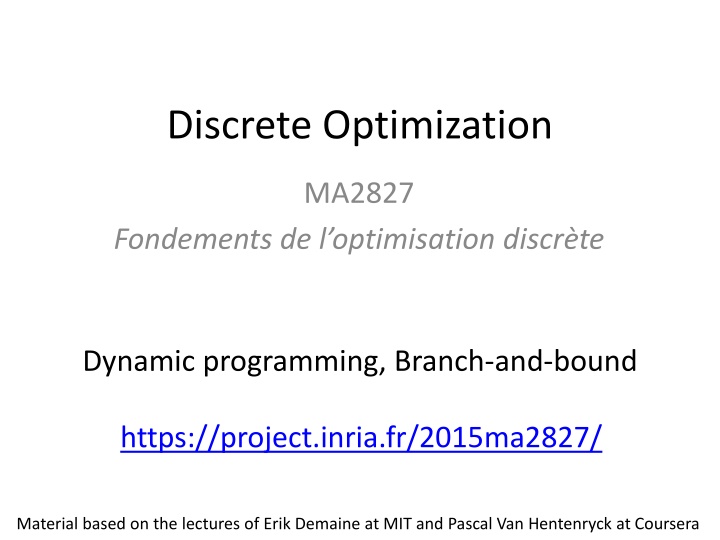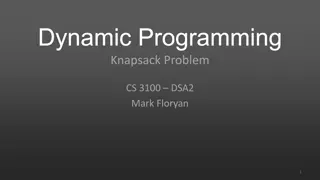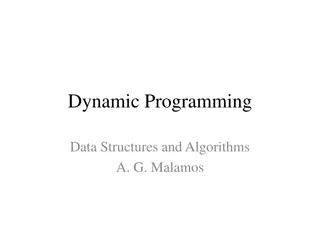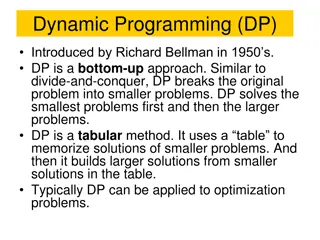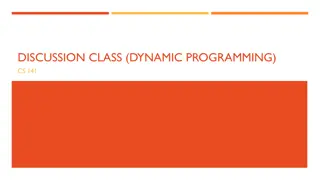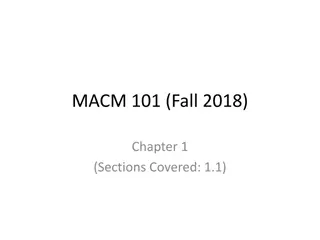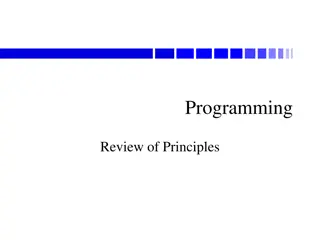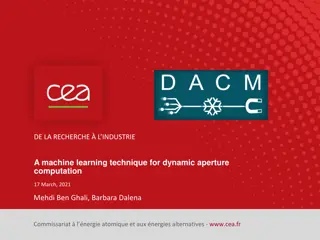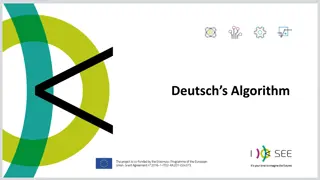Dynamic Programming in Discrete Optimization: A Powerful Algorithm Design Technique
Dynamic programming is a powerful algorithm design technique that allows solving complex problems efficiently by breaking them down into overlapping subproblems. This approach, as discussed in the material based on the lectures of Erik Demaine at MIT and Pascal Van Hentenryck at Coursera, involves recursion and reusing solutions to optimize computations. The content covers topics such as Fibonacci numbers, shortest paths, text justification, knapsack problem, and branch-and-bound methods. The importance of memoization in improving the efficiency of dynamic programming is also highlighted through examples and algorithms.
Download Presentation

Please find below an Image/Link to download the presentation.
The content on the website is provided AS IS for your information and personal use only. It may not be sold, licensed, or shared on other websites without obtaining consent from the author.If you encounter any issues during the download, it is possible that the publisher has removed the file from their server.
You are allowed to download the files provided on this website for personal or commercial use, subject to the condition that they are used lawfully. All files are the property of their respective owners.
The content on the website is provided AS IS for your information and personal use only. It may not be sold, licensed, or shared on other websites without obtaining consent from the author.
E N D
Presentation Transcript
Discrete Optimization MA2827 Fondements de l optimisation discr te Dynamic programming, Branch-and-bound https://project.inria.fr/2015ma2827/ Material based on the lectures of Erik Demaine at MIT and Pascal Van Hentenryck at Coursera
Outline Dynamic programming Fibonacci numbers Shortest paths Text justification Parenthesization Edit distance Knapsack Branch-and-bound More dynamic programming Guitar fingering, Hardwood floor (Parquet) Tetris, Blackjack, Super Mario Bros.
Dynamic programming Powerful technique to design algorithms Searches over exponential number of possibilities in polynomial time DP is a controlled brute force DP = recursion + reuse
Fibonacci numbers Recurrence: F1 = F2 = 1, Fn = Fn-1 + Fn-2 Task: compute Fn
Fibonacci numbers: nave algorithm Recurrence: F1 = F2 = 1, Fn = Fn-1 + Fn-2 Task: compute Fn Na ve algorithm: def fib(n): if n <= 2: f =1 else: f = fib(n-1) + fib(n-2) return f
Fibonacci numbers: nave algorithm Recurrence: F1 = F2 = 1, Fn = Fn-1 + Fn-2 Task: compute Fn Na ve algorithm has exponential running time: T(n) = T(n-1) + T(n-2) + O(1) Fn n Easier: T(n) >= 2T(n-2) => T(n) = O(20.5n)
Fibonacci numbers: nave algorithm Recurrence: F1 = F2 = 1, Fn = Fn-1 + Fn-2 Task: compute Fn Na ve algorithm has exponential running time:
General idea: memoization Recurrence: F1 = F2 = 1, Fn = Fn-1 + Fn-2 Task: compute Fn Memoized DP algorithm: memo = {} def fib(n): if n in memo: return memo[n] if n <= 2: f =1 else: f = fib(n-1) + fib(n-2) memo[n] = f return f
General idea: memoization Recurrence: F1 = F2 = 1, Fn = Fn-1 + Fn-2 Task: compute Fn Why memoized DP algorithm is efficient? fib(k) recurses only when called first time n nonmemoized calls for k=n, n-1, , 1 memoized calls take O(1) time overall running time is O(n) Footnote: better algorithm is O(log n)
General idea: memoization DP recursion + memoization Memoize (save) & re-use solutions to subproblems Time = #subproblems time/subproblem Memoized calls take constant time
General idea: bottom-up DP Recurrence: F1 = F2 = 1, Fn = Fn-1 + Fn-2 Task: compute Fn Bottom-up DP algorithm: def fib(n): memo = {} for k in range(1, n+1): if k <= 2: f =1 else: f = memo[k-1] + memo[k-2] memo[k] = f return memo[n]
General idea: bottom-up DP Recurrence: F1 = F2 = 1, Fn = Fn-1 + Fn-2 Task: compute Fn Bottom-up DP algorithm: Exactly the same computation as memoized DP Need topological sorting of the subproblems Dependency graph:
General idea: bottom-up DP Recurrence: F1 = F2 = 1, Fn = Fn-1 + Fn-2 Task: compute Fn Bottom-up DP algorithm: Exactly the same computation as memoized DP Need topological sorting of the subproblems In practice is faster (no recursion calls) Analysis is easier Can save space
Shortest paths Task: find shortest path (s, v) from s to v Recurrence: Shortest path = shortest path + last edge (s, v) = (s, u) + w(u, v) How do we know what is the last edge? Guess! Try all the guesses and pick the best
Shortest paths Task: find shortest path (s, v) from s to v Recurrence: (s, v) = min{ (s, u) + w(u, v) | (u, v) E } Memoized DP algorithm: memo = {} memo[s] = 0 def (s, v): if not v in memo: memo[v] = min{ , (s, u) + w(u, v) | (u, v) E } return memo[v]
Shortest paths Task: find shortest path (s, v) from s to v Recurrence: (s, v) = min{ (s, u) + w(u, v) | (u, v) E } Does this work? Execution order: 1. (s, v) 2. (s, a) 3. (s, s) 4. (s, b) 5. (s, v) - infinite recursion a s v b
Shortest paths Task: find shortest path (s, v) from s to v Recurrence: (s, v) = min{ (s, u) + w(u, v) | (u, v) E } Does this ever work? If there are no oriented loops (graph is a DAG) works fine Complexity O(V + E)
Shortest paths Task: find shortest path (s, v) from s to v Recurrence: (s, v) = min{ (s, u) + w(u, v) | (u, v) E } Graph of subproblems has to be acyclic (DAG)! (need this property to topologically sort)
Shortest paths Task: find shortest path (s, v) from s to v Recurrence: (s, v) = min{ (s, u) + w(u, v) | (u, v) E } How do we fix the recursion? Add more subproblems! k(s, v) = shortest path from s to v using at most k edges
Shortest paths Task: find shortest path (s, v) from s to v Recurrence: k(s, v) = min{ k-1(s, u) + w(u, v) | (u, v) E } Time= #subproblem time/subproblem Base case: k(s, s) = 0, k 0 0(s, u) = , u s #subproblem = O( V2 ) time/subproblem = O( indegree of v ) Time = O( V E ) Goal: V-1(s, v) Bellman-Ford algorithm is dynamic programming!
Shortest paths Task: find shortest path (s, v) from s to v Recurrence: k(s, v) = min{ k-1(s, u) + w(u, v) | (u, v) E } Graph of subproblems: length of the path
Summary DP careful brute force DP recursion + memoization + guessing Divide the problem into subproblems that are connected to the original problem Graph of subproblems has to be acyclic (DAG) Time = #subproblems time/subproblem
5 easy steps of DP Analysis: #subproblems 1. Define subproblems #choices 2. Guess part of solution time/subproblem 3. Relate subproblems (recursion) time 4. Recurse + memoize OR build DP table bottom-up - check subprobs be acyclic / topological order extra time 5. Solve original problem
5 easy steps of DP Fibonacci Shortest paths k(s, v), v V, 0 k V Fk, 1 k n 1. Subproblems V2 #subproblems n Fn-1, Fn-2 2. Guessing edges coming into v #choices 1 indegree(v) k(s, v) = min{ k-1(s, u) + w(u, v) | (u, v) E } 3. Recurrence Fn= Fn-1+ Fn-2 O( 1 ) O( indegree(v) ) time/subproblem 4. Topological order for k = 1, , n for k = 0, 1, , V - 1 for v V total time O( n ) O( V E ) V-1(s, v) 5. Original problem Fn extra time O( 1 ) O( 1 )
5 easy steps of DP Fibonacci Shortest paths k(s, v), v V, 0 k V 1. Subproblems Fk, 1 k n V2 #subproblems n 2. Guessing Fn-1, Fn-2 edges coming into v #choices 1 indegree(v) 3. Recurrence Fn = Fn-1 + Fn-2 k(s, v) = min{ k-1(s, u) + w(u, v) | (u, v) E } time/subproblem O( 1 ) O( indegree(v) ) 4. Topological order for k = 1, , n for k = 0, 1, , V - 1 for v V total time O( n ) O( V E ) 5. Original problem Fn V-1(s, v) extra time O( 1 ) O( 1 )
Text justification Task: split the text into good lines Greedy algorithm (MS Word/Open Office): put as many words on the first line, repeat Optimal dynamic programming! (LATEX)
Text justification Task: split the text into good lines Define badness(i, j) for line of words[ i : j ] from i, i+1, , j-1 In LATEX: badness = if total length > page width badness = (page width total length)3 Goal: minimize overall badness
Text justification Task: split the text into good lines Goal: minimize overall badness Subproblems: min. badness for suffix words[ i : ] #subproblems = O( n ) where n = #words Guesses: what is the first word of the next line, j #choices = n i = O( n ) Recurrence: DP( i ) = min{ badness(i, j) + DP( j ) | for j = i+1, , n } time/subproblem = O( n )
Text justification Task: split the text into good lines Goal: minimize overall badness Topological order: for i = n 1, n 2, , 0 i j n total time = O( n2 ) Final problem: DP( 0 )
General idea: parent pointers Task: split the text into good lines Goal: minimize overall badness How to find the actual justification? Parent pointers simple general idea Remember which guess was best and save argmin At the end, follow the parent pointers starting from the final problem
Useful subproblems for sequences Input is a sequence/string x Subproblems: 1. Suffixes x[ i : ] #subproblems = O( n ) 2. Prefixes x[ : i ] #subproblems = O( n ) 3. Substrings x[ i : j ] #subproblems = O( n2 )
Parenthesization Task: Optimal evaluation of associative expression A[0] A[1] A[n 1] (e.g., multiplying matrices)
Parenthesization Task: Optimal evaluation of associative expression A[0] A[1] A[n 1] (e.g., multiplying matrices) Guesses: outermost multiplication #choices = O( n ) Subproblems: Prefixes & suffixes? NO Recurrence:
Parenthesization Task: Optimal evaluation of associative expression A[0] A[1] A[n 1] (e.g., multiplying matrices) Guesses: outermost multiplication #choices = O( n ) Subproblems: Cost of substring A[ i : j ], from i to j-1 #subproblems = O( n2 ) Recurrence: DP( i, j ) = min{ DP( i, k ) + DP( k, j ) + cost of (A[i] A[k-1] ) (A[k] A[j-1]) | for k = i + 1, , j 1 } time/subproblem = O( j i ) = O( n )
Parenthesization Task: Optimal evaluation of associative expression A[0] A[1] A[n 1] (e.g., multiplying matrices) Topological order: increasing substring size total time = O( n3 ) Final problem: DP[ 0, n ] parent pointers to recover parenthesization
Edit distance Task: find the cheapest way to convert string x into y Operations with cost: insert c delete c replace c with c Examples: Spell checking (typos) DNA comparison
Edit distance Task: find the cheapest way to convert string x into y Operations with cost: insert c delete c replace c with c If insert and delete cost 1 and replace costs is equivalent to longest common subsequence HIEROGLYPHOLOGY MICHAELANGELO
Edit distance Task: find the cheapest way to convert string x into y Operations with cost: insert c delete c replace c with c If insert and delete cost 1 and replace costs is equivalent to longest common subsequence HIEROGLYPHOLOGY MICHAELANGELO Answer: HELLO
Edit distance Task: find the cheapest way to convert string x into y Subproblems: c[ i, j ] = edit-distance( x[ i : ], y[ j : ] ), 0 i |x|, 0 j |y| #subproblems = O( |x| |y| ) Guesses: x[ i ] deleted, y[ j ] inserted, x[ i ] replaced with y[ j ] #choices = 3 time/subproblem = O( 1 ) Recurrence: c( i , j )=min{ cost( delete x[ i ] ) + c( i + 1, j ), if i < |x|; cost( insert y[ j ] ) + c( i, j + 1 ), if j < |y|; cost( replace x[ i ] with y[ j ] ) + c( i + 1, j + 1 ), i < |x|, j < |y| }
Edit distance Task: find the cheapest way to convert string x into y Topological order: DAG in 2D table total time = O( |x| |y| ) Final problem: c( 0, 0 ) parent pointers to recover the path
Edit distance Example of traversal from right to left
Knapsack Task: pack most value into the knapsack item i has size si and value vi capacity constraint S choose a subset of items to max the total value subject to total size S
Knapsack Task: maximize value given S, si , vi Subproblems: value for prefix i: items 0, , i 1 #subproblems = O( n ) Guesses: include item i or not #choices = 2 Recurrence: DP[ i + 1 ] = max{ DP[ i ], vi + DP[ i ] if si S }
Knapsack Task: maximize value given S, si , vi Subproblems: value for prefix i: items 0, , i 1 #subproblems = O( n ) Guesses: include item i or not #choices = 2 Recurrence: DP[ i + 1 ] = max{ DP[ i ], vi + DP[ i ] if si S } Not enough information to know whether item i fits. How much is left?
Knapsack, version 1 Task: maximize value given S, si - integer, vi Subproblems: value for prefix i (items 0, , i 1) given knapsack of size s #subproblems = O( n S ) Guesses: include item i or not #choices = 2 Recurrence: DP[ i + 1, s ] = max{ Base-case: DP[ 0, 0 ] = 0; DP[ 0, s ] = , s = 1, , S DP[ i, s ], vi + DP[ i, s - si ] if si S } time/subproblem = O( 1 )
Knapsack, version 1 Task: maximize value given S, si - integer, vi Topological order: for i = 0, , n 1: for s in 0, , S: total time = O( n S ) Final problem: find maximal DP[ n 1, s ], s = 0, , S parent pointers to recover the set of items
Knapsack, version 1 Task: maximize value given S, si - integer, vi Is O( n S ) good running time? Polynomial time = polynomial in input size Here O( n ) if number S fits in type int O( n log S ) is polynomial S is exponential in log S (not polynomial) Pseudopolynomial time = polynomial in the problem size AND the numbers in input
Knapsack, version 2 Task: maximize value given S, si, vi - integer Subproblems: size for prefix i (items 0, , i 1) given items of value v #subproblems = O( n V ) Guesses: include item i or not #choices = 2 Recurrence: DP[ i + 1, v ] = min{ DP[ i, v ], si + DP[ i, v - vi ] if vi v } Base-case: DP[ 0, 0 ] = 0; DP[ 0, v ] = , v = 1, , V time/subproblem = O( 1 )
Knapsack, version 2 Task: maximize value given S, si, vi - integer Topological order: for i = 0, , n 1: for v in 0, , V: total time = O( n V ) Final problem: find DP[ n, v ] S with maximal possible v
